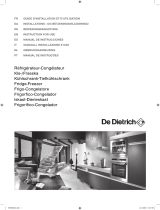Brandt BIS2202SW Owner's manual
- Category
- Fridge-freezers
- Type
- Owner's manual
This manual is also suitable for
Groupe Brandt BIS2202SW is a fridge-freezer designed for household use. The lower part is a fridge for storing fresh food above 0°C, and the upper part is a freezer intended for freezing fresh food and long-term storage of frozen food (up to a year). The freezer compartment is marked with four stars. It features adjustable glass shelves, a foldable egg rack, a pull-out glass shelf with adjustable height, door bottle rack with safety holder, and interior light. The control panel allows for temperature adjustment and turning the fan on/off.
Groupe Brandt BIS2202SW is a fridge-freezer designed for household use. The lower part is a fridge for storing fresh food above 0°C, and the upper part is a freezer intended for freezing fresh food and long-term storage of frozen food (up to a year). The freezer compartment is marked with four stars. It features adjustable glass shelves, a foldable egg rack, a pull-out glass shelf with adjustable height, door bottle rack with safety holder, and interior light. The control panel allows for temperature adjustment and turning the fan on/off.




















-
 1
1
-
 2
2
-
 3
3
-
 4
4
-
 5
5
-
 6
6
-
 7
7
-
 8
8
-
 9
9
-
 10
10
-
 11
11
-
 12
12
-
 13
13
-
 14
14
-
 15
15
-
 16
16
-
 17
17
-
 18
18
-
 19
19
-
 20
20
-
 21
21
-
 22
22
-
 23
23
-
 24
24
Brandt BIS2202SW Owner's manual
- Category
- Fridge-freezers
- Type
- Owner's manual
- This manual is also suitable for
Groupe Brandt BIS2202SW is a fridge-freezer designed for household use. The lower part is a fridge for storing fresh food above 0°C, and the upper part is a freezer intended for freezing fresh food and long-term storage of frozen food (up to a year). The freezer compartment is marked with four stars. It features adjustable glass shelves, a foldable egg rack, a pull-out glass shelf with adjustable height, door bottle rack with safety holder, and interior light. The control panel allows for temperature adjustment and turning the fan on/off.
Ask a question and I''ll find the answer in the document
Finding information in a document is now easier with AI
Related papers
Other documents
-
De Dietrich DRS1332J Troubleshooting guide
-
Smeg FC 375 B NF User manual
-
Smeg UKC325XNF Instructions For Use Manual
-
Smeg UKC375XNF Troubleshooting guide
-
IKEA FDN 810 Program Chart
-
Gorenje HTPI1466 Operating instructions
-
 De Dietrich DRP831JE Owner's manual
De Dietrich DRP831JE Owner's manual
-
Summit CP36 User manual
-
SEVERIN KS9822 Datasheet
-
Summit FS-56L User manual
























